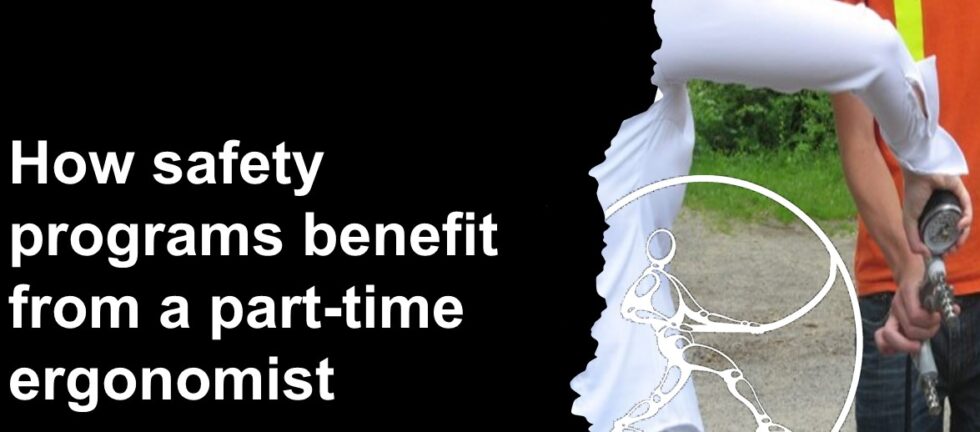I’ve seen a lot of postings for Health and Safety jobs lately, some of which include “ergonomics” responsibilities such as completing physical demands analyses or manual handling assessments. Safety professionals who have an ergo background could certainly fulfil these responsibilities. However, once in the role, we’ve noticed that safety/ergo professionals tend to be consumed with the “safety” aspects of a safety program. Legislation requires noise sampling, GHS, and workplace inspection tasks to be completed and documented. Injury investigation consumes time. Ergonomics almost always falls to the bottom of the priority list. Even though most organizations are paying more compensation for strains/sprains than for any other category of injury, little time remains to investigate and address these injuries. What’s the solution?
A part-time ergonomist can focus exclusively on strain/sprain hazards, without getting drawn into the competing responsibilities associated with your safety program. A consulting ergonomist can operate without the administrative tasks associated with “being an employee” – no department meetings, annual HR training, paid vacation, stat holidays, or sick days. No equipment or software to buy. Imagine if a full-time safety person could say, “Every Thursday is ergo day. I will focus on nothing but ergonomics on Thursdays.” A consulting ergonomist can do just that.
A consulting ergonomist practices ergonomics full-time, and therefore maintains a current knowledge of best practices, and has access to all the most current analysis tools and equipment. (We know very little about asbestos legislation or the intricacies of LOTO, but we know ergo. 100% of our professional development is aimed at being better ergonomists.) We’ve found that it’s rare for a safety/ergo person to be provided with calibrated force gauges, dynamometers, and biomechanics software. They may not have experience in other sectors, and or with the advances in ergonomic tools and devices. The experience of a consulting ergonomist, and access to resources, offers focused value.
And if we’re talking about Taylor’d Ergo’s consulting ergonomists, they come with additional advantages; we provide ergo awareness materials at no extra cost. Our “on-site ergo” clients receive monthly ergo bulletins and weekly ergo thoughts to share with employees. We hold an ergo contest twice per year, including handouts and draw prizes. We have a mountain of handouts and puzzles available for clients to distribute. The ergonomist can lead ergo training for targeted groups of employees, which is already developed and ready to run.
What do our clients say?
“The program supports itself. The intangible benefits of having an ergonomist on site is a positive addition to team (both hourly & salary). Having an onsite resource, is a welcomed support for an HSE professional. From completing an office assessment, to reviewing a challenging repetitive motion task. There are many way to view corrective actions, an ergonomist’s eye brings a great deal of value.”
“The way the PDCA was done increased the level of understanding of the challenges employees face during their daily tasks. Engagement of the employees during the assessment was perceived as partnership and included an educational aspect. The employees involved were comfortable with the assessor in both providing feedback and receiving advice related to ergonomics aspects of their work task.”
“Christina has been amazing as our ‘on-site’ ergonomist. Having her available on a regular schedule allows me to direct her work where needed, making sure our employees have the support when they need it. The range of services that she is able to support also gives me access to the skills I need to support our programs in a cost-effective way.”
“Having the ergonomist on-site regularly decreases workers compensation and health care costs for our company by determining risk factors and resolving them before injuries can occur. The physical demands analyses that are completed allow us to better job match our employees to ensure a safe return to work for our employees. Taylor’d Ergonomics helps keep a safe work environment for all our employees. It keeps our employees engaged. Employees see that the company is putting forth their best efforts to ensure their health and safety which increases employee morale.”


